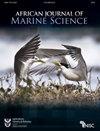Magellan mussels Aulacomya atra from the South African coast show high diversity within populations but a lack of geographic differentiation
IF 1.4
4区 生物学
Q3 MARINE & FRESHWATER BIOLOGY
引用次数: 0
Abstract
The Magellan mussel Aulacomya atra is a bivalve mollusc found along parts of the South African and Namibian coastline. Its numbers were low historically compared with other indigenous species but have decreased further since the 1970s owing to habitat invasion by Mediterranean mussels Mytilus galloprovincialis. We studied sequences of the mitochondrial cytochrome oxidase subunit 1 (CO1) and the nuclear internal transcribed spacer (ITS1) of A. atra to determine patterns of differentiation among three localities on the South African coastline and the phylogenetic position of these populations relative to other populations of Aulacomya species in the Southern Hemisphere. Results from both mitochondrial and nuclear genes revealed a high level of diversity within South African populations from the west and south coast, with little to no geographic differentiation among these populations. Phylogenetic trees constructed using maximum likelihood and haplotype network analysis show that individuals from all three regions sampled are intermingled in groups with low bootstrap support. Our CO1 sequences exhibited a phylogeographic structure concordant with the spatial distribution in South Africa, Argentina, Chile and New Zealand. However, results for ITS1 showed a lack of differentiation over a large spatial scale stretching from South Africa to New Zealand. Future studies should include additional samples from across the species’ distributional range and the examination expanded to include genetic markers with adaptive significance.来自南非海岸的麦哲伦贻贝Aulacomya atra在种群中表现出高度多样性,但缺乏地理差异
麦哲伦贻贝Aulacomya atra是一种双壳类软体动物,在南非和纳米比亚的部分海岸线上发现。与其他本地物种相比,其数量历史上较低,但自20世纪70年代以来,由于地中海贻贝(Mytilus galloprovincialis)入侵栖息地,其数量进一步减少。研究了A. atra线粒体细胞色素氧化酶亚基1 (CO1)和核内转录间隔区(ITS1)的序列,以确定南非海岸线三个地区的分化模式,以及这些种群相对于南半球其他Aulacomya物种种群的系统发育位置。线粒体和核基因的结果显示,在南非西部和南部海岸的人群中,存在高度的多样性,这些人群之间几乎没有地理差异。利用最大似然和单倍型网络分析构建的系统发育树表明,这三个地区的个体混合在低自举支持的群体中。CO1序列的系统地理结构与南非、阿根廷、智利和新西兰的空间分布一致。然而,ITS1的结果显示在从南非到新西兰的大空间尺度上缺乏分异。未来的研究应该包括来自物种分布范围的额外样本,并扩大到包括具有适应意义的遗传标记。
本文章由计算机程序翻译,如有差异,请以英文原文为准。
求助全文
约1分钟内获得全文
求助全文
来源期刊

African Journal of Marine Science
生物-海洋与淡水生物学
CiteScore
2.60
自引率
16.70%
发文量
17
审稿时长
6-12 weeks
期刊介绍:
The African (formerly South African) Journal of Marine Science provides an international forum for the publication of original scientific contributions or critical reviews, involving oceanic, shelf or estuarine waters, inclusive of oceanography, studies of organisms and their habitats, and aquaculture. Papers on the conservation and management of living resources, relevant social science and governance, or new techniques, are all welcomed, as are those that integrate different disciplines. Priority will be given to rigorous, question-driven research, rather than descriptive research. Contributions from African waters, including the Southern Ocean, are particularly encouraged, although not to the exclusion of those from elsewhere that have relevance to the African context. Submissions may take the form of a paper or a short communication. The journal aims to achieve a balanced representation of subject areas but also publishes proceedings of symposia in dedicated issues, as well as guest-edited suites on thematic topics in regular issues.
 求助内容:
求助内容: 应助结果提醒方式:
应助结果提醒方式:


